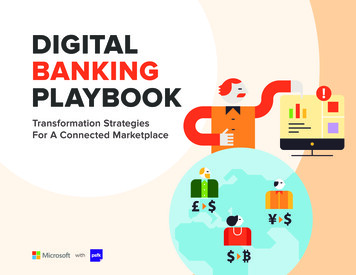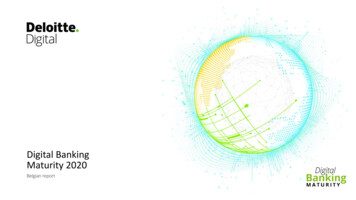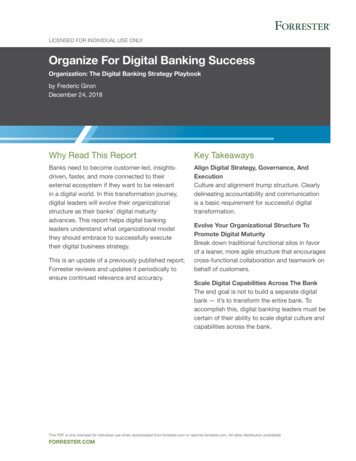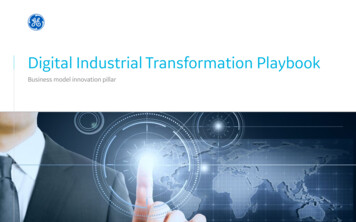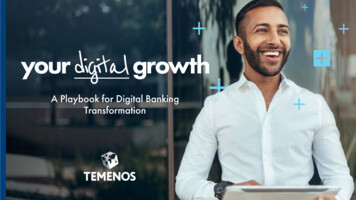
Transcription
A Playbook for Digital BankingTransformation1
Contents3Banking in an era of accelerating change4The digital banking maturity curve6Your digital growth: where are you today?8Chart a path toward digital growth9How to get started12 Six key things to consider as you go throughthis process14 What to expect from this journey15 Empowering banks & credit unions on theirjourney of digital growth16 Banking applications: build or buy?17 Your Digital Growth—Powered byTemenos Infinity2
Banking in an era of accelerating changeDigital banking growth and transformation is notnew; what’s changed and what puts pressureon banks to change is customer expectation.Technology has created a revolution in whichcustomers today expect smoother, more consistentexperiences regardless of communication channel.Unfortunately for financial institutions, whencustomers compare banking technology andapplications with other technology in their lives,banking technology is just not competitive.Your customers’ latest digital experience creates the standard towhich they will compare your technology. While most customersare still waiting for a new banking experience, they won’t wait long,and that puts banks at risk of becoming a mere back-office utility.While bankers know that change in the industry is inevitable, theyface a digital banker’s dilemma—how can they balance keepingthe lights on and keeping up with competitors while also drivinginnovation to differentiate in a crowded market?To compete, larger banks are aggressively investing in innovation.However, smaller banks and credit unions don’t need to get caughtup in a technological arms race. Some of these institutions havefound a smarter way to protect their customer bases. Instead ofattempting to outspend larger institutions, successful smaller financialinstitutions are out-partnering them.In an out-partnering strategy, smaller organizations are marryingtheir expertise in banking with fintech’s emerging technologies.As a result, they are finding themselves able to gain and retain acompetitive advantage. But as financial institutions continue on thepath to digital banking, many are finding that a comprehensiveapproach to digital is still elusive.This playbook is designed to help you accelerate your digitalgrowth by offering the practical guidance and ready-to-useinformation you need to achieve a digital banking transformation.3
The digital banking maturity curveInvestmentAccording to Forrester’s 2018 report Track Digital BankingSuccess with Customer-Centric Metrics, “Customers today turnto an increasing number of touchpoints to discover, explore, andbuy banking products and engage with banks. Banks must movebeyond product-centric and channel-specific measures.”Omni-channelcustomer experienceMost banks realize they need to improve and they have beentrying to respond to customer demand, but many are finding it tobe an arduous journey that requires a significant investment oftime and resources as they struggle with out-of-date technology,skill gaps, organizational and cultural challenges, and unrelentingregulatory demands.Goal:profitablecustomergrowthStrategic digitalplatformTactical digitaldeploymentFunctional coreEvolving coreTime4
As a result, many small-to-medium banks andcredit unions find that digital banking growth iselusive. Typically, most banks and credit unionsfind themselves in one of the following five states:1. Functional core:4. Strategic digital platform:This is where banks have invested in establishing a strong,traditional and safe core system that delivers the fundamentalsof banking. Technology defines the experiences that customershave and the pace of any technological change is controlled bytechnology partners. Driving change is slow and expensive.This is the first step to a fully agile and customer-centeredbanking experience. Banks that have reached this stage arecommitted to digital banking transformation as a majorbusiness initiative. Technology and business work together to attractnew customers and to retain and grow the value of the ones thatthey already have. Banks at this point understand the importance ofmodernizing how they deliver services and they invest accordingly.They seek a digital platform approach and put the foundationin place to take full control over their roadmap. Banks are nowthinking about and implementing solutions that help them get andstay ahead of their competitors and meet customer needs.2. Evolving core:Some banks are pushing their core system providers to moveforward with digital experiences but, again, the timeline is in thesuppliers’ hands. The bank or credit union does not have controlover its roadmap, and its digital strategy is defined by the investmentpriorities of the core system provider. Banks at this stage often findthemselves suffering from a case of too little, too slowly.3. Tactical digital deployment:At this stage, banks focus on tactics instead of vision. Many banksdecide to solve their most immediate problems themselves, oftenwith either off-the-shelf solutions or by investing time and moneyin developing a native application. These solutions can solvea problem temporarily, but there is limited room for growth orevolution. Banks are also still left with systems that don’t talk to eachother, and resources are spent on integration with core systemsrather than excellence in experience design.5. Omni-channel customer experience:Financial institutions at this level are completely in tune withtheir customers’ needs. They have a prioritized roadmap, and,because of their agile mindset and planning, they can still pivot ifcustomers’ needs change or the market is disrupted. These institutionsexperience growth, see a reduction in cost-to-serve, and can buildthe kind of bank that people want to work with and for. Frictionlessexperiences across all interactions and devices generate greatcustomer relationships. This in turn drives revenue. Reaching this leveltakes hard work, time and money but the rewards are worth the effort.5
Your digital growth: where are you today?Most financial institutions have already beguna digital banking transformation, but many arestruggling to realize their goals, and some lacka strategic plan. To create a digital bankingtransformation roadmap, you must first betterunderstand where your institution currently standswithin the industry benchmarks shown on thematurity curve. Here are four key questions tohelp you self-evaluate your position on the digitalbanking maturity curve.How does the banking experience you offercompare to what your competitors provide?Exploring this question: As more competitors enter the marketand other financial institutions improve their offerings, it’s imperativeto track how your organization compares. This is the first step tocreating a roadmap because it will help you differentiate whereyou need to be digitally versus where you currently are.What are the biggest internal barriers todelivering the digital banking experience thatyou want?Exploring this question: Change can be an incredibly painfulprocess, especially for financial institutions, which depend on theirreliability and stability for success. However, internal barriers can beremoved with the appropriate planning and information.In-depth evaluation questions: Are there any specific customerexperiences that you can offer today that you know other banksalso provide? Are there any specific customer experiences that youcurrently offer that distinguishes your organization from competitors?In-depth evaluation questions: Which people, processesor technologies are making it difficult for you to innovate? Arethere use cases in the industry or from similar industries (such ashealthcare) that can help you move forward?How do you feel, specifically, about the digitalbanking experience you offer today?How would you describe your digitalconfidence today?Exploring this question: As things currently stand, large banksare ahead of smaller institutions in providing a good customerexperience. Consider where your organization excels and where itlags on digital banking experiences for your customers. Pinpointingspecific pain points to address or finding areas that are alreadystrong will help you eliminate the worst problems and learn from,and potentially accentuate, what you’re doing well.Exploring this question: Many financial organizations areplaying catch-up as new waves of digital technology change theway organizations deliver banking services. Financial institutionscan choose many different paths and destinations for theirorganization’s digital banking transformation. Evaluating your digitalconfidence today offers you a starting point as you work towardyour own digital banking transformation.In-depth evaluation questions: Do you have a frictionless andconsistent experience wherever or whenever your customers interactwith you? Where does your organization excel? Where is thereroom for improvement? What is your vision for what you need tooffer to compete?In-depth evaluation questions: How is your digital visionincorporated into your business plan? How close are you to makingdigital a part of your banking DNA versus a standalone workstream?6
After you identifywhere you currentlystand in terms ofmaturity, the nextstep is to chart alogical way forwardfor your institution’sdigital growth.7
Chart a path toward digital growthYou have a vision of the future you want to create for your financial institution. Your vision, combined with a better understanding of your currentposition on the digital banking maturity curve, is the beginning to determining your company’s path for a digital banking transformation. Now you canstart being digitally deliberate and move from theoretical strategizing to making hard plans and taking action.Do we havea problem?Do we havebuy-in to addressthe problem?How could wesolve it?How do wesolve it?How are wedeploying?How do we getmembers toadopt?What impactdid it have?What’s nextin our CXevolution?How do wetalk about oursuccess?Transforming digitalbanking experiencesThe beginning of any changemust start with first asking, “Dowe have a problem?” Perhapsyou’re being reactive and thisproblem is a current customerpain point, or maybe you’rebeing proactive and it’s aforeseen customer experienceissue. Regardless, first confirmthat there is an issue.Next, evaluate internal opinions and buy-in. It’s imperative tohave internal support before addressing the problem. Knowingwhere everyone stands now will help alleviate concerns andeliminate potential delays in the future.Once you have everyone atthe proverbial table, you canstart brainstorming how tosolve the problem. Normally,there are multiple optionsfor solving problems but it’simportant to choose the rightone for your company.Then, and this is one of the hardest steps, figure out deployment.Achieving success at this stage depends on employee buy-in.After employees are engaged, the next step is getting customersto adopt the solution you’ve selected.With the solution in place, it’s now time to examine whether it’s successful. What impacts hasthe solution had, both internally and externally? A successful solution means it’s time to keepimproving. Continuous improvement is the key to long-term success, so ask yourself, “What’snext for improving our customer experience?” Companies that have made it this far are bestin-class. They share insights about their success and establish themselves as industry leaders.There aren’t any financial institutions that can say they are finished with their digital banking transformation because the process is a journey, not a destination. However,some companies are more successful than others on this journey. It’s never too late to get started or recommitted to your digital growth.ExploringEngagingPartnering8
How to get startedFor the first three stages of the journey listed below, here isa guide for what you should be asking yourself and doingto set your bank up for success.Do we have aproblem?Do we havebuy-in to addressthe problem?How couldwe solve it?9
Do we have aproblem?Reasons this question is important: This process begins with acknowledging anissue with customer experience. This question brings a problem to the surface andexposes a business or customer trigger to act: I don’t like I have heard Our KPIs arefalling I have a vision What it accomplishes: This question creates a clear direction and a vision of thefuture to work toward. It also allows you to benchmark your organization against theindustry from a customer experience perspective.Common roadblocks to be aware of: Many financial institutions are experiencingdeclining KPIs, such as lower customer experience measures and lower customeracquisition rates, and there’s a strong pressure to compete combined with indecisionabout what to do next. And while there’s awareness that the institution needs tochange, there’s uncertainty on how to get started. This uncertainty is further complicatedby a lack of market data, resources and internal alignment.What you should be doing: At this stage, it’s important to be focused on where yourcompany currently stands. This includes having an internal business review, holdinga technology roadmap assessment, examining customer experience, and evaluatinghow your company compares to the market or competitors.Do we buy-in to addressthe problem?Reasons this question is important: Before any digital banking transformation canbe successful, there needs to be internal buy-in that the solution agreed upon should be apriority and there needs to be alignment regarding the potential scope for the solution.What it accomplishes: This question helps with alignment across the organization. Forexample, this is your opportunity to get IT and line-of-business leaders’ input and support.This step is where you begin to understand the scale of investment and start to visualizewhat is possible for your bank. You also get the opportunity to clearly define business andcustomer experience goals.Common roadblocks to be aware of: This stage is still fairly early in the planningprocess, so alignment issues are common, including around customer experienceneeds and the technology roadmap. At this stage, it’s also okay to still be workingtoward acceptance of the need to change and the creation of clear, shared goalsacross line-of-business leaders, marketing and customer experience. Constraints fromcore or legacy systems can also create a sense of lack of control over your roadmapand produce a feeling of dependence on core providers.What you should be doing: Keep working toward alignment by holding internalstakeholder meetings and setting up a steering or reviewal committee. At this stage,establish an estimated budget and a priorities list.10
How could we solve it?Reasons this question is important: This is your opportunity to explorepossibilities. What options do you have to solve the customer experience problem?How can you distinguish yourself in the industry?What it accomplishes: Now is the time to explore the market for options to solveyour problem. Learn who the key players are and what technology is out there tosupport your goals. Consider what other banks have done in similar situations butalso look at adjacent industries to see how they’re solving analogous problems.Make sure to use this time to understand unique challenges or requirements tosupport existing core or legacy systems.Common roadblocks to be aware of: Searching for solutions introducesoutsiders into what had previously only been an internal discussion. In a multivendorenvironment, this can bring a lot of confusion and noise to the discussion as youdecide how to move forward. There can also be pressure from core providers to staywith them and adopt their available solutions.What you should be doing: Don’t be afraid to look externally for advice andsupport. Network and meet with peers for best practice validation and employ aconsultant to support the process. Reach out to analysts and read analyst content.Create a vendor long list and send out requests for information. Take sales meetingsand don’t be afraid to ask for live demonstrations from vendors. This will help youcreate the vendor short list.Asking and answering these questions is acritically important strategic step for smallfinancial institutions.Although small banks and credit unionsare being outspent and out-marketed bybig banks and fintech, these questions setthe foundation for a smarter tactic:out-partnering the competition.Small financial institutions can stayrelevant by focusing on pain points andcreating partnerships to get ahead of bothcompetitors and customer needs.11
Six key things to consider as you go through this process123Customer understanding.Buy-in.Mode of operation.In a market with many options, customers will choose to usea product that they understand. However, don’t just speculateregarding what offerings customers like and use and what they’reavoiding. Instead, it’s important to put in the additional effort toverify and detail their preferences. Customers will appreciate thatyou want to understand them.For any project to be successful, internal buy-in both in terms ofemotional and financial support, is essential. You need buy-inbefore you can get a budget. Before starting any project, askyourself, “Is budget available? If not, can I get it?”Some banks and credit unions start a transition to digital bankingby moving their technical processes to an agile strategy whilekeeping their business processes (which can often be higher risk) ina more traditional, waterfall model. With the right communicationbetween the two, it’s possible to function this way, and it can makethe transformation journey more attainable over time.Consider: In the short term, evaluate and consider acting onthe feedback you’re getting about your digital experience. In thelong term, your institution should be using data to uncover real-timeinsights and using NPS to track whether your customersare satisfied.Consider: Make a business case from a variety of perspectives togain support across your bank. IT is going to care about differentthings than the marketing department. Build the case for budgetthrough business metrics and make sure to highlight savings for theboard of directors or executive team.Consider: Do you have the right processes in place? Canyou adopt an agile strategy for both technical processesand business processes? What changes to staffing orprocesses will have to happen to make a digital bankingtransformation possible?12
456Total cost of ownership.Key performance indicators.Vendor selection.An essential part of creating a digital banking strategy isunderstanding what the total cost of ownership will be. Noone wants to be stuck investing endlessly in a solution or payinghigh maintenance costs, so do this research upfront to helpfind a satisfying solution.Key performance indicators (KPIs) are an essential tool for overviewand management at any company. What KPIscan now measure can be altered significantly by adoptingnew technology.Choosing the best vendor to partner with is a crucial decision.It can make or break the success of this endeavor. Make sure thevendor’s vision and roadmap are aligned with yours regardingwhat you want to achieve and offer.Consider: What types of KPIs are currently in place? Candigital solutions help them improve?Consider: If the vendor is not thinking about its innovation path, itwon’t be well-suited to support you.Consider: What will be your total cost of ownership if youbuild a solution in-house versus choosing a technology vendor?Some banks and credit unions that have tried to achieve their digitalsolution in-house have ended up spending double. There areoften benefits (such as scalability) to partnering with a vendor thatfocuses on technology.13
What to expect from this journeyDespite not having the resources or ability in-house to quickly buildand deploy the modern banking applications their customersexpect, some banks and credit unions have found ways tosuccessfully improve customer experience with their technology. As2018 Retail Banking Trends and Predictions, a joint digital bankingreport by Jim Marous, the Digital Banking Report, and sponsoredby Kony and Diebold Nixdorf, states, “Being a leader in emergingtechnology is no longer a luxury only for the big players.” Throughstrategic partnerships, these institutions have established themselvesas digital banking leaders.These smaller financial institutions reveal that it is possible to takecontrol of your technology, your roadmap, and your customerexperience, and you can do it now.Being a leader inemerging technology isno longer a luxury onlyfor the big players.
Empowering banks & credit unions on theirjourney of digital growthWherever you are starting out on the maturity curve, the Temenos Infinitydigital banking platform and its powerful banking applications will takeyou from digitally passive to digitally deliberate more quickly and morecost-effectively than you ever imagined possible. And, perhaps mostimportantly of all, Temenos technology will allow you to meet thestandard to which your customers compare your technology andgive them the digital experience they want.InvestmentTo move forward, you need a powerfultechnology platform that enables you to transformyour digital banking experience quickly andcost-effectively while also improving customerinteractions with your business. When huntingfor a technology to help your company’s digitalbanking transformation, you don’t have to choosebetween build or buy, you can have the best ofboth stomer experienceGoal:profitablecustomergrowthStrategic digitalplatformTactical digitaldeploymentFunctional coreEvolving coreTime/investment with Temenos InfinityTime15
Banking applications: build or buy?You have a lot of decisions to make as you gothrough your digital banking transformation andone of the most important will be deciding whetherto build your applications or buy them.There are some very appealing benefits to developing applicationsin-house, but the reality for most banks that develop their ownapplications is that nearly all their resources become invested intrying to keep them running and up-to-date. This means they’reunable to provide customers with high impact experiences becauseof resource constraints. Temenos Infinity delivers the best of bothbuild and buy, offering a platform and applications. It can meetinstitutions where they are without sacrificing what’s critical now andin the future. By partnering with Temenos, you’re able to innovateahead of industry leaders without spending like the leaders.Pre-builtapplicationCustomdevelopmentPros: Fast to market Lower resource requirement Easier maintenancePros: Roadmap control Unique/differentiation Enhanced securityCons: No control of roadmap No differentiation Expensive to customizeCons: Slow to market Higher resource requirement Ongoing dev dilemmaTemenos InfinityRetail BankingTemenos DigitalBanking Platform16
Your Digital Growth—Powered byTemenos InfinityTemenos empowers banks and credit unionsto transform digital banking experiences andaccelerates their transformation so they cancompete today. By putting banks and credit unionsin control now, Temenos enables them to takecontrol of their future.“Temenos had very fewlimitations related to connectingto our vendor partners and ourcore banking systems. Workingwith Temenos, we were ableto accelerate the time frame todeliver a fully functional mobilebanking application.”Dawn Brummett, SVP and Chief Operations Officer, shares ORNLFederal Credit Union’s experience working with Temenos. “Temenoshad very few limitations related to connecting to our vendorpartners and our core banking systems. Working with Temenos, wewere able to accelerate the time frame to deliver a fully functionalmobile banking application.”Unlike rigid out-of-the-box application providers, Temenosempowers accelerated deployment of a full portfolio of frictionless,personalized and secure banking applications that both attract newcustomers and drive long-term customer loyalty.Temenos Infinity delivers a portfolio of turnkey applications for digitalbanking, which lowers implementation costs compared to customdevelopment and also provides easy integration with existing coresystems. Temenos enables banks and credit unions to future-prooftheir customer relationships by enabling rapid delivery of exceptionaldigital banking experiences that keep pace with changing customerneeds. On your journey to digital banking growth, don’t outspendyour competition, out-partner them.
We welcome the opportunity to havea conversation.TALK TO AN ADVISORVisit us at Temenos.com.18
Dec 17, 2019 · path to digital banking, many are finding that a comprehensive approach to digital is still elusive. This playbook is designed to help you accelerate your digital growth by offering the practical guidance and ready-to-use information you need to achieve a di
